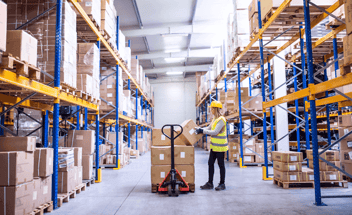Discover how automation is revolutionizing the logistics industry and optimizing operations for 3PL companies.
The Evolution of Automation in Logistics
Automation has significantly transformed the logistics industry over the years. With the advancements in technology, manual processes have been replaced by automated systems, leading to increased efficiency and productivity. In the past, logistics operations heavily relied on manual labor for tasks such as order processing, inventory management, and transportation planning. However, with the introduction of automation, these processes have become streamlined and more accurate.
One of the key drivers of automation in logistics was the development of Warehouse Management Systems (WMS). These systems enable 3PL companies to automate various warehouse tasks, such as receiving, put-away, picking, and packing. By implementing WMS, companies can optimize space utilization, reduce picking errors, and improve overall warehouse efficiency. Automation in warehouses has revolutionized inventory management, allowing for real-time tracking, accurate stock counts, and faster order fulfillment.
Benefits of Automation in 3PL Operations
Automation brings numerous benefits to 3PL operations. One of the major advantages is increased efficiency. Automated systems can perform tasks faster and with greater accuracy compared to manual labor, resulting in reduced processing times and improved customer satisfaction. Moreover, automation reduces the risk of human errors, which can be costly and time-consuming to rectify.
Another benefit of automation in 3PL operations is cost savings. By automating repetitive tasks, companies can significantly reduce labor costs. Additionally, automation allows for better resource allocation, as systems can analyze data and make informed decisions on inventory levels, transportation routes, and order prioritization. This optimization leads to lower operational costs and improved profitability.
Furthermore, automation enhances scalability in 3PL operations. As businesses grow, they can easily scale their operations by implementing automated systems. With automation, companies can handle higher order volumes, manage complex supply chains, and meet customer demands more effectively. This scalability is crucial for 3PL companies to stay competitive in the rapidly evolving logistics industry.
Enhancing Efficiency through Automated Warehouse Management
Automated warehouse management is a game-changer for 3PL companies. With the help of advanced technologies such as barcode scanning, RFID tagging, and robotics, warehouses can operate at peak efficiency. These technologies enable faster and more accurate order processing, reducing the time it takes to fulfill customer orders.
One of the key benefits of automated warehouse management is improved inventory accuracy. Automated systems can track inventory levels in real-time, ensuring that stock counts are always up to date. This eliminates the need for manual stock checks and minimizes the risk of stockouts or overstocking. Additionally, automated systems can optimize storage space utilization, ensuring that products are stored in the most efficient manner.
Furthermore, automation in warehouse management enhances order accuracy. By automating picking and packing processes, companies can eliminate errors caused by manual handling. This leads to higher customer satisfaction and fewer returns or exchanges.
Optimizing Transportation with Automated Routing and Tracking
Automation plays a crucial role in optimizing transportation for 3PL companies. Automated routing and tracking systems enable companies to plan and execute transportation operations more efficiently.
Automated routing systems analyze various factors such as distance, traffic conditions, and delivery time windows to determine the most optimal routes for transportation. By minimizing travel distances and optimizing routes, companies can reduce fuel consumption, lower transportation costs, and improve delivery times. Additionally, automated routing systems can dynamically adjust routes in real-time based on changing circumstances, such as traffic congestion or road closures, ensuring that shipments are delivered on time.
Automated tracking systems provide real-time visibility into the location and status of shipments. This not only enables companies to provide accurate and timely updates to customers but also allows for proactive management of potential disruptions. With automated tracking, companies can quickly identify and address any issues that may arise during transportation, such as delays or route deviations.
Automation's Impact on Supply Chain Visibility
Automation has greatly improved supply chain visibility for 3PL companies. Through the use of advanced technologies such as IoT sensors, cloud-based platforms, and data analytics, companies can gain real-time insights into their supply chain operations.
Automated systems can collect and analyze vast amounts of data, providing companies with valuable information on inventory levels, demand patterns, and delivery performance. This enhanced visibility allows companies to make data-driven decisions, optimize inventory levels, and improve overall supply chain efficiency.
Moreover, automation enables better collaboration and communication among supply chain partners. With automated systems, companies can easily share and exchange data with suppliers, manufacturers, and customers, ensuring that everyone has access to accurate and up-to-date information. This collaboration leads to improved coordination, reduced lead times, and enhanced customer satisfaction.





Leave a Comment